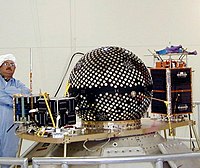SAPPHIRE (Stanford AudioPhonic PHotographic IR Experiment, also called Navy-OSCAR 45) was a satellite built by the Stanford University students in Palo Alto, California.[1]

 SAPPHIRE satellite | |
| Mission type | Communications |
|---|---|
| Operator | USNA / University of Santa Clara |
| COSPAR ID | 2001-043D[1] |
| SATCAT no. | 26932 |
| Mission duration | 2 years and 6 months |
| Spacecraft properties | |
| Manufacturer | Stanford University |
| Launch mass | 16 kg (35 lb) |
| Start of mission | |
| Launch date | 30 September 2001, 02:40 UTC |
| Rocket | Athena 1 LM-001 |
| Launch site | Kodiak LP-1 |
| Contractor | Lockheed Martin |
| End of mission | |
| Disposal | Decommissioned |
| Last contact | 2005 |
| Orbital parameters | |
| Reference system | Geocentric |
| Regime | Low Earth |
| Eccentricity | 0.0[1] |
| Altitude | 794 km (493 mi)[1] |
| Inclination | 67°[1] |
| Period | 101 minutes[1] |
| Epoch | 30 Sep 2001[1] |
The satellite was launched on September 30, 2001 together with Starshine 3, PICOSat and PCSat on an Athena 1 rocket at the Kodiak Launch Complex, Alaska, United States.
Its purpose was the training of students, the operation of an infrared sensor, a digital camera, a speech synthesizer and from 2002 the operation of an APRS digipeater.[2] He also served to train midshipmen of the US Naval Academy in the field of satellite control.
The satellite's mission ended in early 2005.
Frequencies
- Uplink: 145.945 MHz
- Downlink: 437.1 MHz
- Mode: 1200 bit/s AFSK
- Call sign: KE6QMD[3]
See also
External links
References
Wikiwand in your browser!
Seamless Wikipedia browsing. On steroids.
Every time you click a link to Wikipedia, Wiktionary or Wikiquote in your browser's search results, it will show the modern Wikiwand interface.
Wikiwand extension is a five stars, simple, with minimum permission required to keep your browsing private, safe and transparent.
